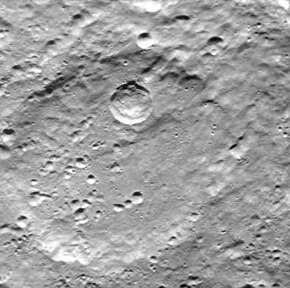
Degas is a rayed crater on Mercury at latitude 37.5 N, longitude 127 W. Its diameter is 54 kilometres (34 mi). It was named after the French impressionist painter Edgar Degas in 1979. The rays consist of light colored material blasted out during the crater's formation. Craters older than Degas are covered by the ray material, while younger craters are seen superimposed on the rays. Degas forms a crater pair with Brontë to the north. Both lie near the center of Sobkou Planitia.

Chao Meng-Fu is a 167 km (104 mi) diameter crater on Mercury named after the Chinese painter and calligrapher Zhao Mengfu (1254–1322). Due to its location near Mercury's south pole and the planet's small axial tilt, an estimated 40% of the crater lies in permanent shadow. This combined with bright radar echoes from the location of the crater leads scientists to suspect that it may shelter large quantities of ice protected against sublimation into the near-vacuum by the constant −171 °C (−276 °F) temperatures.
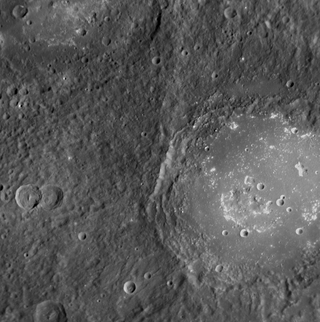
Lermontov is an impact crater on the planet Mercury. The crater is named after Mikhail Yuryevich Lermontov, a 19th-century Russian poet. The name was approved by the International Astronomical Union in 1976.
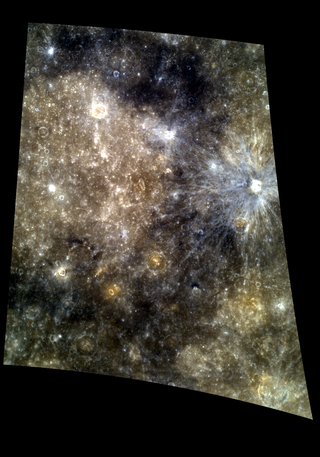
Tolstoj is a large, ancient impact crater on Mercury. It was named after Leo Tolstoy by the IAU in 1976. The albedo feature Solitudo Maiae appears to be associated with this crater.

Michelangelo is a 230 km diameter impact basin in the Michelangelo quadrangle of Mercury, which is named after this crater. The crater itself was named by the IAU in 1979 after the Italian painter, sculptor and architect Michelangelo.

Vivaldi is a crater on Mercury. It was named by the IAU after Italian composer Antonio Vivaldi in 1976. It has a prominent and nearly continuous inner ring whose diameter measures about half that of the outer ring. It is one of 110 peak ring basins on Mercury. Unlike some of the lunar multiringed structures, no vestiges of additional rings are apparent around this crater. It is classified as c3 age.

Mozart is a crater on Mercury, named by the IAU in 1976 after Austrian composer Wolfgang Amadeus Mozart.
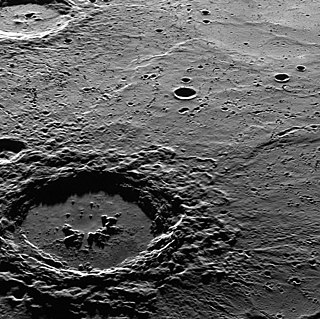
Hokusai is a rayed impact crater on Mercury, which was discovered in 1991 by ground-based radar observations conducted at Goldstone Observatory. The crater was initially known as feature B. Its appearance was so dissimilar to other impact craters that it was once thought to be a shield volcano. However improved radar images by the Arecibo Observatory obtained later in 2000–2005 clearly showed that feature B is an impact crater with an extensive ray system. The bright appearance of rays in the radio images indicates that the crater is geologically young; fresh impact ejecta has a rough surface, which leads to strong scattering of radio waves.

Calvino is a crater on Mercury. Its name was adopted by the IAU in 2016, after the Italian writer Italo Calvino.

Balzac is a crater on Mercury. Its name was adopted by the International Astronomical Union in 1976. Balzac is named for the French writer Honoré de Balzac, who lived from 1799 to 1850.

Bernini is a crater on Mercury. It has a diameter of 146 kilometers. Its name was adopted by the International Astronomical Union (IAU) in 1976. Bernini is named for the Italian architect and sculptor Gian Lorenzo Bernini, who lived from 1598 to 1680.
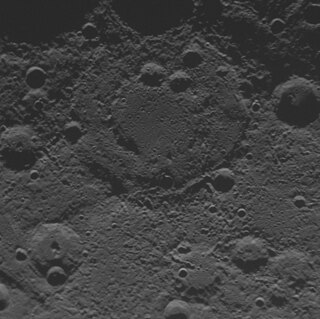
Cervantes is a crater on Mercury. It has a diameter of 181 kilometers. Its name was adopted by the International Astronomical Union in 1976. Cervantes is named for the Spanish writer Miguel de Cervantes, who lived from 1547 to 1616.

Dickens is a crater on Mercury. It has a diameter of 78 kilometers. Its name was adopted by the International Astronomical Union (IAU) in 1976. Dickens is named for the English novelist Charles Dickens, who lived from 1812 to 1870.

Hawthorne is a crater on Mercury. It has a diameter of 120 kilometers. Its name was adopted by the International Astronomical Union in 1979. Hawthorne is named for the American novelist Nathaniel Hawthorne, who lived from 1804 to 1864.

Keats is a crater on Mercury. The crater's name was adopted by the International Astronomical Union (IAU) in 1976 and named after an English poet. This poet is known as John Keats, who lived from 1795 to 1821.

Liang Kʻai is a crater on Mercury. It has a diameter of 140 kilometers. Its name was adopted by the International Astronomical Union in 1979. Liang Kʻai is named for the Chinese artist Liang Kai, who lived from 1140 to 1210.

Mark Twain is a crater on Mercury. Its name was adopted by the International Astronomical Union (IAU) in 1976. Mark Twain is named for the American author Mark Twain, who lived from 1835 to 1910.

Monet is a crater on Mercury. Its name was adopted by the International Astronomical Union (IAU) in 1979. Monet is named for the French artist Claude Monet, who lived from 1840 to 1926.

The Face on Moon South Pole is a region on the Moon that was detected automatically in an image from the Lunar Reconnaissance Orbiter by a computer system using face recognition technologies, as a result of a project that was part of the International Space App Challenge 2013 Tokyo. It is composed of craters and shadows on the Moon's surface that, together, form an image resembling a face.

Giambologna is a crater on Mercury. Its name was adopted by the International Astronomical Union (IAU) on December 16, 2013. Giambologna is named for the Flemish sculptor Jean Boulogne Giambologna.
